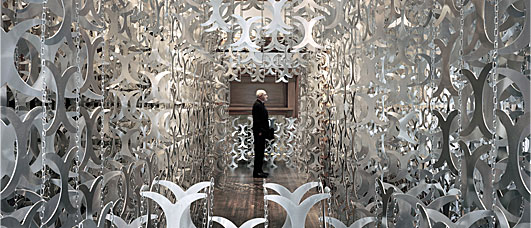 Spring 2010
Spring 2010|
“We cannot copy directly nature into architecture, but we learn from the principles.” - Cecil Balmond
|
The Reinventor
Legendary engineer Cecil Balmond, whose work is on view for the first time in Pittsburgh, is literally changing our landscape by melding engineering
Cecil Balmond inside H_edge, on view in the Forum Gallery through May 30. Photos Courtesy of ARUP
Strolling through the aluminum lacework of H_edge, the current installation in Carnegie Museum of Art’s first-floor Forum Gallery, visitors marvel at the delicate effect of chains that seem to hang, magically, in midair. Then they discover that they’re as sturdy as concrete. The 6,000 aluminum plates in Cecil Balmond’s creation, held rigid in a forest of vertical steel chains, actually rise from the floor, in a strapping, precise pattern that also allows the panels to turn at will. Executing abstract mathematical patterns in real-life aesthetic proportions is the special genius of Balmond, a London-based structural engineer and designer who has collaborated on some of the most spectacular architectural projects of the 21st century. Balmond’s work, says Raymund Ryan, curator of Carnegie Museum of Art’s Heinz Architectural Center, “is about finding an essential relationship between numbers and systems.” The unifying argument of his work, says Balmond, is to “let space entertain us.” Balmond is the deputy chairman of Arup, an international design firm that translates the visions of the world’s top architects into soaring public structures. With world-renowned sculptor Anish Kapoor, Balmond envisioned an unsupported 550-foot-long fabric tube for a 2002 installation at London’s Tate Modern; he spent five months with Kapoor to achieve the sensational result. Similarly, Balmond worked with Dutch architect Rem Koolhaas on the radical CCTV building that has two leaning towers and weds an animate sense of structure to form. For artistic collaborations with other luminaries including Toyo Ito, Daniel Libeskind, and Álvaro Siza, Balmond jets from Abu Dhabi to Beijing to Copenhagen and Singapore. Calling Balmond “the most influential engineer working today,” Ryan believes H_edge’s small-scale but sophisticated exploration of mathematics, space, and tectonics makes the piece an ideal fit for Carnegie Museums. “It appeals to our core mission,” notes Ryan. “The rational aspect of the work appeals to the scientific end of the spectrum, whereas the aesthetic surprise appeals to the fine art end.” A series of light boxes exhibited with the work explore Balmond’s theories and influences, and a wall-sized digital drawing projected alongside depicts the Menger sponge, a cube in constant motion. And while the mathematical concept may seem esoteric to some, it’s beautifully simple to Balmond, whose inspirations range from Einstein to daVinci to Bach. “H_edge looks extremely complex, but it’s one simple unit,” says its creator. “It starts with a cube. A hole is drilled through one face. It divides any face into nine equal squares, and so on, with lots of voids and solids.” Balmond’s architecture students at the University of Pennsylvania assembled his design for H_edge, on view at the Museum of Art through May 30. The Philadelphia campus is one of two homes for Balmond’s playful pedestrian bridge projects, in which he stepped into the role of architect for the first time. The Weave Bridge, which he describes as “coiling in space,” winds above Amtrak’s rail line through Penn’s campus. In Coimbra, a Portuguese university town, two halves of a narrow bridge over the Mondego River lean against each other at the center of the span, providing a series of changing perspectives and a casual meeting point. Pittsburgh’s ravines and rivers, Ryan believes, could provide a fascinating context for similar structures. Balmond’s meditations on the power of numbers as organizational systems inform his practice in Arup’s Advanced Geometry Unit, the research-focused design group he founded in 2000. It’s also led the 66-year-old, Sri Lankan-born polymath to writing, radio, and even TV. He tackled the magic of numbers through time and cultures for a well-received BBC series, Numbers That Made the World. Also a talented guitarist, he cites the works of Bach as his deepest inspiration. “It’s very tactile. You feel the way he was composing,” says Balmond. “He built these amazing forms, the cello suites above all. They’re amazing, they are inspirational, even as background when I’m working.” In his firm’s work on the bold shapes of the Beijing Olympics venues—the National Stadium known as the Bird’s Nest and the natatorium called the Water Cube—Arup used computer modeling to realize architectural visions. But Balmond says he begins each project with pen in hand. “I always draw a first sketch and then use computer modeling, which in turn I sketch over and back and forth. My inner eye directs the work, not the computer.” He acknowledges, though, that technology “has made it easier to go into complex systems feeling confident that I have tools at my disposal. Look at da Vinci, experimenting with pigments and paints. All artists and inventors in every field are obliged to use the highest technology they’ve got.” Balmond says that revolutions in building materials are advancing. “They will make an impact on thinner elements for architecture,” he predicts. “They will still be held by physics, of forms being static and safe for people, but there will be materials commercially available for designs we haven’t yet found.” Among those he foresees are materials with memory—based on nature, like muscles and ligaments—that can stretch, contract, and flop. “I study nature to discover its deeper structure,” he says. “We cannot copy directly nature into architecture, but we learn from the principles, the way nature builds from a small unit to create successes that look variable.” |
Also in this issue:
I Just Want to Watch · The Next 15 · Regenerative Medicine: A Growing Future · Run, bounce, spin, climb— and learn! · President's Note · NewsWorthy · Face Time: Heather White · Science & Nature: Our Super-sized World · About Town: Asking Andy · The Big Picture
 |
Copyright © 2017 CARNEGIE Magazine. All rights reserved. |

